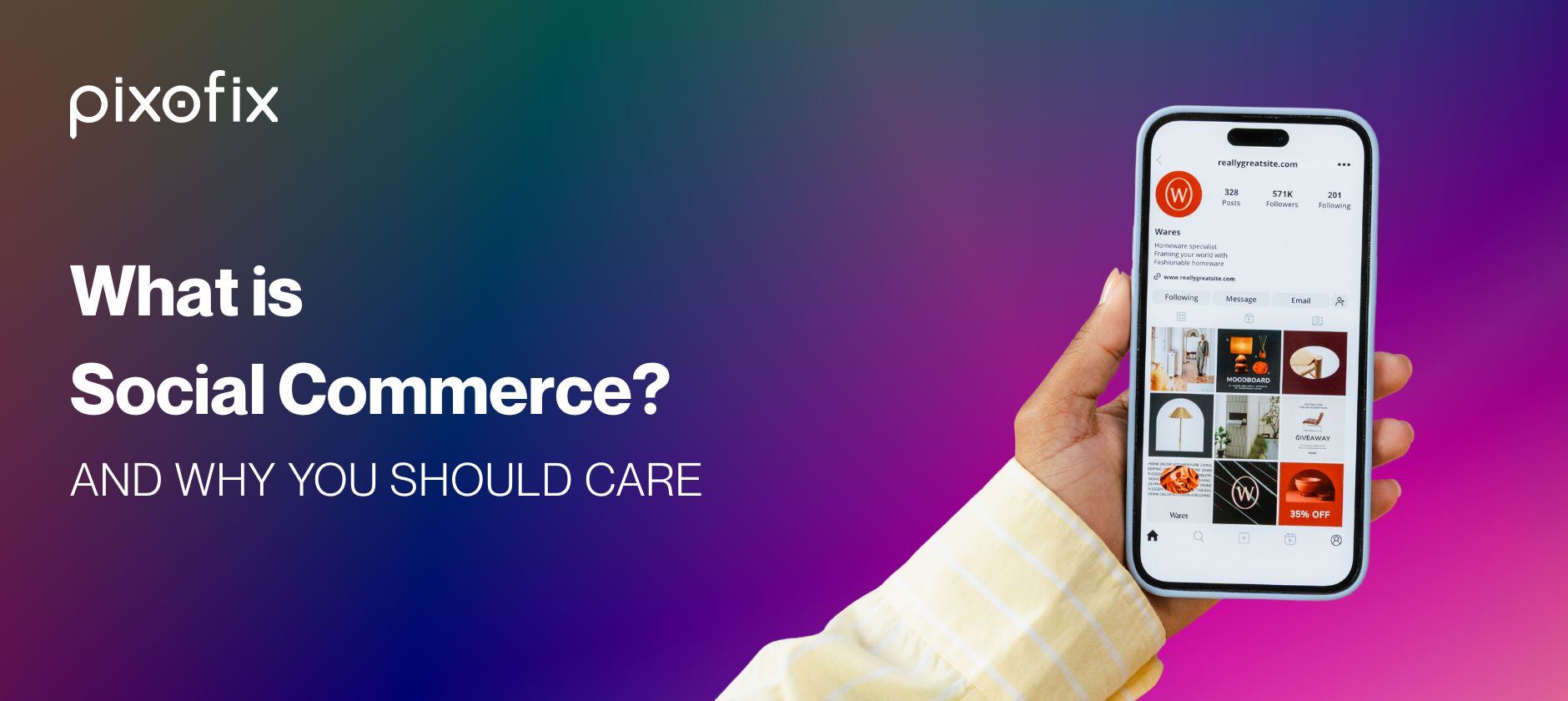Why Social Commerce Matters for E-Commerce
Shift in Consumer Behavior
Buying habits are no longer confined to search bars or checkout carts. Consumers now shop where they scroll. Whether it’s a viral product video or a friend tagging a brand in a story, the line between inspiration and purchase has practically vanished.
Before, people discovered products, looked them up, then bought. Now, discovery and purchase often happen in the same swipe. That behavioral shift is huge for ecommerce brands. It means your products need to show up exactly where your audience already spends their time — inside the feed.
And visual-first content isn’t optional. Clean, fast-loading, emotionally resonant product imagery is what convinces shoppers to act. Algorithms may get your content seen, but it’s the visuals that drive interaction.
Integration of Social Media and Shopping
Social platforms aren’t just adding shopping features. They’re becoming storefronts. Instagram Shops, TikTok Shopping, Pinterest Product Pins — they all bake ecommerce into native browsing. It’s immersive. It’s direct. And it’s fast.
For brands, this melding of media and marketplace is a game-changer. You’re not waiting for someone to land on your website. You’re delivering a full shopping experience across visuals, captions, and interactions — all in one ecosystem. No redirects. No friction.
To stand out, visual content has to speak fast and say a lot. That’s why more brands are refining their production pipelines, building agile photo teams, and using retouching partners like Pixofix to keep product visuals sharp, real, and conversion-ready across every platform.
What Is Social Commerce?
Definition and Overview
Social commerce is the intersection where social media and ecommerce collide — and collaborate. It’s the practice of selling products directly through social platforms, using native tools for discovery, engagement, and purchase.
Unlike traditional ecommerce, social commerce invites the shopper into an ongoing visual and social experience. Buying is just one part. There's also liking, sharing, saving, commenting — all actions layered over rich visuals and peer influence.
It’s not just about flash sales and tagged products. It’s about creating a shopping environment where people feel part of a brand’s story. Every product image, every interaction, becomes part of that narrative.
Social Commerce vs. E-Commerce
Ecommerce builds the store. Social commerce builds the crowd.
Standard ecommerce funnels users from ad to webpage to checkout. Social commerce removes steps. Instead of sending people to your store, you're opening your store inside the social platform itself.
Where ecommerce is transactional, social commerce is experiential. It relies heavily on content — especially video and imagery — to connect and convert.
And with short attention spans, that content needs to do double duty: look amazing and perform fast. That’s why teams lean on tools like Pixofix, not just for polishing pixels, but for building scalable workflows that maintain quality across hundreds of SKUs and countless formats.
Key Components of Social Commerce
Shoppable Posts
Shoppable posts turn passive scrolling into active buying. With product tags embedded directly in photos and videos, users can explore details or purchase without leaving the app.
But the power of a shoppable post lies in its visuals. It has to feel native in the feed, yet branded. Aspirational, without being sterile. That kind of balance starts with excellent imagery and clean, consistent styling. Tools like Pixofix help execute this at scale, ensuring each frame tells the right story and points to the right product.
User-Generated Content
UGC doesn’t just build trust — it fuels conversions. When customers post authentic photos using your product, it turns your audience into your best marketers.
Social commerce thrives on this kind of social proof. But just because it’s organic doesn’t mean it can’t be refined. Smart brands lightly retouch or apply subtle consistency to featured UGC, so it aligns with their aesthetic without losing its raw charm. The key is realism over polish — something creative retouching teams, like Pixofix, understand at a team level.
Influencer Collaborations
Influencers aren’t just spokespeople. In social commerce, they’re conversion channels. The right creator with the right audience can drive mid-scroll purchases simply by integrating your product into their content — no sales pitch needed.
It works best when the visuals don’t scream "ad." It's about seamless integration that fits both their aesthetic and yours. That means prepping high-quality product shots, offering style guides, and sometimes coordinating editing flows between influencers and your own photo teams.
Interactive Shopping Experiences
Social commerce doesn’t stop at image and caption. With features like polls, AR try-ons, live shopping streams, and story quizzes, it brings two-way interaction into the buying process.
This isn’t just engagement for engagement’s sake. It’s data. It’s feedback. It’s commerce wrapped in entertainment. And all of it relies on visuals that can carry the load — fast-loading, on-brand product content that feels immersive without being overwhelming.
Building this requires tight creative alignment. AI tools and automation can help lay the groundwork, but the final finesse comes from human touch — color grading, realism, context. Pixofix fits here, helping ecommerce studios craft and deliver ready-to-deploy assets built for dynamic, in-app experiences.
Leading Social Commerce Platforms
Instagram is where aesthetic meets action. With Shops, Product Tags, Reels, and in-app checkout, it offers an end-to-end social commerce experience.
Visual content rules here. Your grid is your store window, and the quality of that imagery dictates trust. Every photo must be on-brand, fast, and form a cohesive story. Many leading brands streamline production with automated tools and partners like Pixofix to ensure product visuals work across grid posts, stories, and ads — without skipping on polish.
Facebook may be older, but it’s still powerful in social commerce. Its Marketplace, Shops, and live stream selling features make it ideal for brands targeting multiple demographics.
Especially in live shopping events or community-driven groups, visual storytelling matters. Smart brands create compelling cover photos, lifestyle graphics, and product carousels that feel personal yet professional. Fast editing workflows — often powered by AI-assisted retouching — help brands stay responsive to this platform’s fast-moving content needs.
TikTok
TikTok flips the script. Discovery drives everything, and product sales often start with a trend, not a catalog.
Social commerce happens organically here. Brands ride virality, partner with creators, and seed entertaining yet informative videos that blend product use with storytelling. That kind of content needs speed — both in production and retouching. Teams use automated editing pipelines, then bring in partners like Pixofix for real-world skin tones, natural lighting tweaks, and platform-specific visuals that still feel native.
Pinterest is visual search on steroids. It’s also the quiet giant of social commerce, thanks to Product Pins and direct Shopify integration.
Here, consistency is key. Your pins need to shine across formats: long verticals, square crops, zoomed-in textures. That takes more than batch editing. It takes a style system. Brands that win on Pinterest often have strict visual standards, with partners ensuring their product photos stay sharp, fast, and inspirational across seasonal campaigns.
YouTube
Long-form video isn’t off the table. YouTube’s product tagging in videos, Shorts, and community posts makes it a surprising but strong player in social commerce.
For brands that have tutorials, reviews, or influencer unboxings, the thumbnails, overlays, and product visuals have to be precise. Workflows that support faster retouching and consistent brand feel — like those offered by Pixofix — ensure your visuals don’t get lost in motion blur or screen fatigue.
Benefits of Social Commerce for Businesses
Increase Brand Awareness
Social commerce cracks open new audiences. Every share, comment, and save can turn a single post into an introduction for thousands of potential customers.
But awareness only turns to interest when visuals stop the scroll. That’s why brands are investing in consistently stunning product content — cleaned, retouched, and resized for each platform without losing story or quality.
Enhance Customer Engagement
It’s no longer about passive audiences. Social commerce invites interaction — reactions, polls, live chat, carousel swipes.
The catch? Every micro-interaction circles back to how your brand looks. A soft blur, the wrong crop, or off-tone lighting can drop engagement instantly. That’s why retouching strategy matters. Not just fixing flaws, but crafting a visual language that speaks directly to your audience.
Streamline Purchase Processes
Click-to-buy used to be nice. Now it’s required. Social commerce removes layers of friction, offering one-tap purchases embedded in content.
But for that to work well, product presentation must be instant, clear, and actionable. That means loading fast. Looking sharp. Having consistent CTA placement. Behind the scenes, brands often rely on creative ops teams and photo partners like Pixofix to prep large volumes of visuals that meet platform specs without compromising on quality.
Utilize Data for Targeted Marketing
Behavior on social platforms generates a goldmine of data — what products get saved, shared, or ignored. That feedback loop helps refine targeting, messaging, and creative choices.
But quality data needs quality inputs. If your visuals are inconsistent or poorly executed, you're optimizing against noise. Solid imagery, aligned with each platform’s best practices, gives you cleaner signals. It lets your marketing team test what really performs. Then dial it in. Then scale.## Best Practices for Implementing Social Commerce
Know Your Audience
Everything starts here. If you don't understand who you're talking to, the rest doesn't matter. Social commerce is intimate — you're entering people's feeds, not just their wallets. Track what formats your audience prefers. Does your customer engage with unboxings, carousel explainers, short reels? Analyze reactions, story replies, even emoji usage. That’s intel.
Use those cues to craft content that resonates. Gen Z expects radically real. Millennials lean into style and storytelling. Map tone and format to mood and moment. When teams align creative with audience behavior, every post becomes a nudge closer to conversion.
Create High-Quality Visuals
You’ve got milliseconds — maybe less. Your visual game has to be sharp, consistent, and unmistakably yours. This isn't about making things look pretty. It's about making things look believable, desirable, and fast.
Build a production pipeline that can scale. Start with clean photography. Layer in storytelling. Then retouch with precision. Skip generic filters. Lean into realism, texture, tone. Brands often turn to creative partners like Pixofix for exactly this: fast-turnaround product imagery that feels crafted, not canned. Because when your image sells the moment, it sells the product.
Optimize Hashtags and Keywords
This is your discoverability engine. Right tags and terms make your content surface at the perfect time — during scrolls, searches, or trend spikes. Start with platform specifics: TikTok tags skew fast and quirky, Pinterest leans evergreen, Instagram mixes trend and niche.
Don’t just chase what’s trending. Map tags to intent. Use brand keywords alongside product descriptors and emotion triggers. Hashtags aren’t filler — they’re fuel. The sharper your taxonomy, the better your chance to land in feeds that convert.
Schedule Posts for Maximum Impact
Timing isn’t random — it’s strategy. Your audience has scroll patterns. Study them. Catch them on their commute, lunch break, or wind-down hours. Tools like Later, Buffer, or Meta’s native scheduler can help you post when engagement surges.
But scheduling goes beyond time slots. Think cadence. Are you posting the right formats at the right rhythm? Alternate product drops with UGC. Mix quick tutorials with slow-motion reveals. Align launch calendars with post timing. Smart teams plan content around when people are primed to act, not just to browse.
Metrics to Measure Success in Social Commerce
Conversion Rates
This is the ultimate scorecard. Did the post move someone from a scroll to a cart? In social commerce, conversion doesn't always mean checkout. It might be tap-to-view, Save, or Add to Wish List — micro-conversions that signal buying intent.
Track conversion by content type: What’s turning views into action? Carousel how-tos? Creator collabs? Shoppable Reels? Then double down. Creative optimization starts where conversion metrics end.
Customer Engagement Levels
Comments, likes, saves, shares — these aren’t vanity. They're signals. High engagement tells you content is resonating. But what kind? Are people asking questions? Tagging friends? Reacting emotionally? Metrics like Story replies or AR try-on completions can reveal what kind of visual experience pulls users in.
Engagement also tells platforms your content matters. That boosts reach. So the better your visuals and storytelling, the more likely you are to get rewarded by the algorithm.
Return on Investment
Social commerce is cost-heavy on visuals and production — but when done right, it pays back fast. Track ROI by mapping content costs against attributed sales. If a creator-led campaign sold 300 units from a $700 shoot + retouch budget, that’s gold.
In hybrid workflows, where human editors partner with AI and tools like Pixofix, brands often decrease turnaround times without losing craft. That faster execution boosts ROI by letting teams test more content, more often, with higher consistency.
Mistakes to Avoid in Social Commerce Strategy
Neglecting Audience Insights
Guesswork is expensive. Assumptions sink campaigns. If you’re not constantly tracking what your audience responds to — format, tone, timing, creators — you’re wasting effort on beautiful content that no one wants.
Social commerce is a feedback loop. That loop breaks when brands post in a vacuum. Let performance guide strategy shifts. Let insights shape creative briefs. Otherwise, you're throwing polish at the wrong picture.
Overlooking Mobile Optimization
Your feed lives in one place: the phone. Cropping errors, slow load times, misaligned CTAs — they all kill mobile conversions. If your visuals weren’t designed for swipe navigation, tap overlays, or vertical display, they don’t belong in social commerce.
Optimize everything for mobile: file size, aspect ratio, placement of calls to action. Many teams streamline this by working with retouching experts like Pixofix, who prep assets specifically for mobile-first campaigns without sacrificing aesthetic quality.
Failing to Engage and Respond
This isn’t broadcast. It’s conversation. If someone tags your product or asks a question and hears silence, that’s a missed sale. Maybe five.
Engagement isn't just a job for your social media manager. It’s an entire loop: brand voice, product team info, even image teams that can respond with shareable visuals. Strong social commerce strategies build fast-response pipelines—including pre-approved content—for when the comments start driving intent.
Tools and Technologies for Social Commerce
E-Commerce Integrations
To sell in-feed, you need seamless back-end links. That means integrating your ecommerce platform (Shopify, WooCommerce, BigCommerce) with tools like Meta Shops or TikTok Shopping.
Once connected, your product tags update in real time, stock levels sync, and checkout flows stay smooth. The tighter the integration, the fewer blockers in the path from interest to purchase.
Social Media Management Tools
Posting manually is a grind. Smart brands use platforms like Hootsuite, Sprout Social, Planoly, or Buffer to schedule content, manage comment flow, and analyze reach from a single dashboard.
But don’t let automation dilute your vibe. Timed posts need the same storytelling clarity and visual strength as organic ones. That’s why content batches often go through teams like Pixofix first — to get the consistent polish required for high-stakes, scheduled posts.
Analytics Platforms
You can’t improve what you don't measure. Track beyond likes. Use tools like Meta Business Suite, Google Analytics 4, or tools like Later’s analytics platform to measure real business metrics: sales from posts, drop-off moments, time-to-purchase.
When platforms talk in averages, zoom into your asset-level performance. Did one photo outperform the others? Was it the retouching style, the crop, the lighting? Use this intel to drive your next campaign — not gut feeling.
Practical Workflow Examples for E-Commerce Teams
Step-by-Step Social Commerce Campaign Workflow
- Start with a brief: Who’s the customer? What’s the mission?
- Decide the format mix: Reels, carousels, stories, UGC integrations
- Shoot with social in mind. Framing, props, and crop zones matter.
- Run assets through editing and retouching partners like Pixofix for fast, consistent visuals across formats.
- Tag products through your ecommerce integration
- Schedule and launch
- Monitor in real time. Tweak hero visuals and CTAs based on early signals.
This workflow lets teams work in sprints rather than leaving content to one-off inspiration. It also builds scalability — everyone from photographers to media buyers knows what’s coming next.
Content Calendar for Social Commerce
A solid content calendar isn’t about clocking in posts. It’s a storytelling framework. Plan your primary buckets: Launches, UGC spotlights, creator partnerships, product education, entertainment content.
Then build tension and rhythm. Stack formats based on traction. A creator-sourced video early in the week. A product detail carousel on Wednesday. Live drop or quiz on the weekend.
Keep the calendar agile. Leave room to respond to trends or remix high-performing visuals. Brands often prep multiple visual versions of a post in advance — clean, styled, and size-optimized — with help from partners like Pixofix, so they’re ready to pivot on momentum. That’s speed without chaos.## Transformation Case Studies in Social Commerce
Before and After: Brand A
Brand A, a mid-tier fashion retailer, was running standard ecommerce through their website and occasional Instagram posts. Their visuals? Inconsistent. DIY smartphone shots mixed with outdated stock images. Engagement was low, scroll-throughs high, and conversions were soft.
Then came the pivot.
They built a full social commerce pipeline. Product drops were teased through Reels. Carousels showed off new arrivals styled in different ways. But the biggest shift? Visual consistency. They brought on Pixofix to retouch every product photo to the same aesthetic standard — smooth shadows, true-to-life texture, cohesive lighting. Suddenly, their feed looked curated, not cluttered.
The result? A 3x increase in shoppable post conversions. UGC started rolling in. And their TikTok Shop became their fastest-growing revenue channel. It wasn’t just a prettier feed. It was a product gallery engineered to sell.
Before and After: Brand B
Brand B — a home goods startup — had sleek products but slow sales. Their Instagram felt like a mood board: gorgeous, but disconnected from commerce. Product tags were sporadic. Captions focused on lifestyle, not buying. They treated social as brand-building only.
They shifted strategies by integrating social commerce from the ground up.
Every post started with product in mind. They worked with their content team and partnered with Pixofix to retouch visuals for platform-native formats — square crops for grid posts, subtle animation for stories, high-contrast thumbnails for video. Every frame told a clear product story.
They launched live shopping demos and leveraged creator collabs with direct links. Each asset linked to a tagged product. Each tag linked to a single-tap checkout.
Within two months, social became their top revenue channel. Add-to-cart rates jumped 40% from Instagram traffic alone. The change started with visuals that weren’t just scroll-stopping — they were conversion-starting.






.png)

.png)
